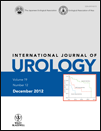Comparison of two inside-out transobturator suburethral sling techniques for stress incontinence: Early postoperative thigh pain and 3-year outcomes
Abstract
Objectives: Inside-out tension-free vaginal tape obturators for the cure of female stress incontinence can cause postoperative thigh pain. The aim of the present study was to analyze and compare the mid-term outcomes of two tension-free vaginal tape obturator procedures.
Methods: Patients diagnosed with urinary stress incontinence were enrolled to undergo a tension-free vaginal tape obturator sub-mid urethral tape operation either by de-Leval's method or by Flam's modification. Peri- and postoperative data were collected by uninvolved researchers and analyzed. Follow up was 36 months.
Results: Overall, 161 patients were included in the study. Cure and complication rates were similar between the two treatment groups. Postoperative thigh pain was significantly more frequent and lasted longer in the de-Leval group compared with the Flam group (31.9% vs 10.0%, respectively). Urinary urgency was more frequent in the de-Leval patients (20.3% vs 2.8%).
Conclusion: Our findings suggest that both tension-free vaginal tape obturator procedures are effective with few adverse effects. The Flam method provides shorter and decreased levels of postoperative thigh pain, as well as reduced long-term postoperative urinary urgency.




